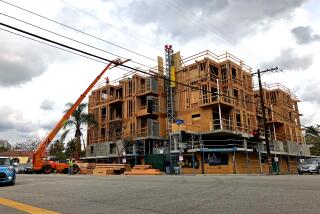L.A. Officials Praise Clinton Aid Program : Revitalization: But some urban business owners question whether the Economic Empowerment Act, which offers tax breaks and job training, would be enough to bring renewal.
- Share via
An urban aid plan announced last week by President Clinton has been praised by city officials as a major step toward revitalizing the inner city, although some business owners questioned whether its incentives would be enough to help them expand and create jobs.
Under the $8.1-billion Economic Empowerment Act of 1993, the federal government would designate 110 poor areas nationwide that would receive a combination of business tax breaks, job-training grants, community-policing funds and other assistance to spur economic development and improve the quality of life. Local officials say Los Angeles is likely to be selected as one of the areas.
“The Clinton proposal appears to present a comprehensive approach to urban development,” said Parker Anderson, general manager of the city’s Community Development Department, which would be one of the lead local agencies involved in administering the federal program.
By offering companies a $5,000 annual tax break for each local worker they employ, the proposal is similar to the state’s enterprise zone program. That program operates on the assumption that giving businesses state tax breaks and other incentives would result in economic renewal.
The city operates five state enterprise zones, including one on the Eastside, one in South Los Angeles and the other near USC. Those zones have had mixed results.
In the Watts Enterprise Zone, which stretches from South-Central into unincorporated county areas and the neighboring cities of Huntington Park, South Gate and Lynwood, officials have spent about $1.3 million in six years to create between 115 and 155 jobs. At least 5,000 businesses are in the zone, but only about 160 have signed up for the program.
However, Anderson said the Clinton proposal goes far beyond the “passive approach” of the state’s enterprise zone program by also providing funds for entrepreneurial training and community policing, which would “nurture the basic human elements needed for development.”
Ezekiel Mobley, a member of the business advisory committee for the Central City enterprise zone near USC, said the Clinton proposal is also different from previous enterprise zone programs because it requires local officials to file detailed plans on how they would work with the private sector to develop a workable program.
The federal government would select its 110 target areas based on those plans and an application documenting the area’s social and economic needs. Those areas would be one of the 10 “empowerment zones” that would receive concentrated assistance, or one of the 100 “enterprise communities” targeted for some of the federal programs.
Officials said details have yet to be worked out and that the proposal would be introduced in Congress as part of a larger budget-related bill. Similar legislation has been introduced in Congress over the past 10 years but has died in committee or been vetoed.
Some business owners were skeptical of the Clinton proposal.
For the Delgado Brothers picture-frame company in South-Central, any tax breaks for hiring new workers would be useless because nearly all of its 80 employees have been there for years, said controller Tom Hermogeno. Business owners also said tax breaks are of no value to companies that are not making money.
Some owners said what they really need is access to low-income loans with the payments spread out over a long period, which would help provide working capital to expand and create jobs.
“Right now, I can’t grow and bring in a new product line because I can’t afford it. And that’s what’s happening everywhere--businesses do not have the capital to work with,” said John Boyd, who owns a furniture-manufacturing company that employs 180 in South Los Angeles.
Boyd also questioned whether federal benefits could outweigh major crime problems. He said his company has been vandalized repeatedly and that one employee was robbed at gunpoint of $75 on April 30. He said he now uses a shotgun to escort his female employees to their cars.
“It’s hard to just get people to work here. Why would you want to be in this area--you’d have to be nuts,” said Boyd, adding that he hopes to move his business out of the city by January.
Officials say the enterprise zones are but one piece of a larger economic puzzle that includes education, job training and the need for credit and capital in areas ignored by financial institutions.
“We know enterprise zones aren’t the answer to everybody’s problems, but they can produce results,” Mobley said.
More to Read
Sign up for Essential California
The most important California stories and recommendations in your inbox every morning.
You may occasionally receive promotional content from the Los Angeles Times.











